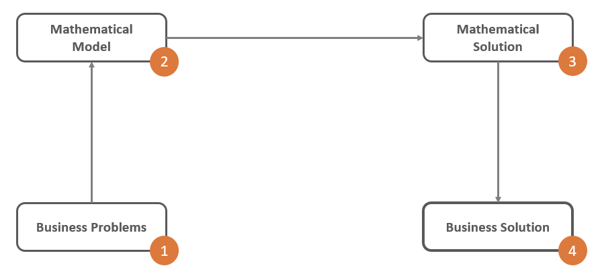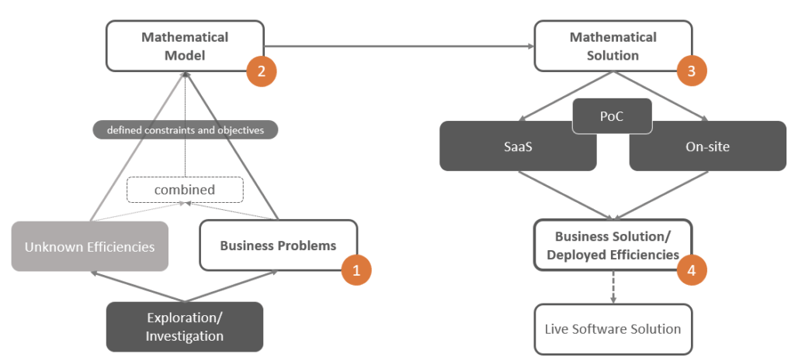Ok, so you’ve read our texts, in various forms, about how optimization is the best thing since sliced bread.
Maybe you already know which process within your organization needs it, what the benefits would be and you already have good-quality data to support the process as well! Now what? (I hear you ask)
You can of course always call us, but let’s be honest, not everyone wants to. It might be a bad moment due to lots of pressing deadlines, our pictures on the website look scary or you just don’t feel like explaining all the background right now.
Not every optimization problem is solved by us and that’s fine. Let’s have a short look at how they are solved then, using either your own data scientists, an off-the-shelf solution or a consulting partner.
Using your own data scientists
Many organizations have their own teams of mathematical experts who also know how to write code, i.e. data scientists.
In-house development is popular and for good reason. It’s easy to modify the models and deployment is smooth when you have got the model developers within your own organization; and in the best case your data scientists have acquired a lot of domain knowledge about the business, which ensures a good match between the model and the real world.
I used to work as a (kind of) data scientist in such a team myself and can attest to all these benefits.

Some organizations sprinkle data science across all business units while others keep all experts in a centralized AI knowledge hotspot. As you can guess there is no correct answer to how this should be done. Disperse or centralize is a choice all organizations have to both plan and experiment with to find the best solution.
Why doesn’t everyone use their own data scientists then?
Sometimes it makes sense to entrust a company with wide knowledge within e.g. one specific domain of AI, such as optimization. In law and accounting services it’s widely accepted that you outsource certain functions, which are either well-specified or rarely occurring.
The same principle applies to software development and its subcategory, data science. If there is a need to develop a new custom solution for production planning, it doesn’t make sense to recruit your own software development team with UX, UI, backend, interface and application architecture expertise and then discard them after the project.
On the other hand having a handful of such experts to take over the solution once it’s developed makes very much sense and ensures you will get the most out of your solution.
Buy an off-the-shelf solution
Route planning is probably the most mature application area of mathematical optimization.
There exists a multitude of software solutions to help with route planning and more efficient fleet utilization.
The same holds true for e.g. production planning, workforce planning or supply chain management. With an off-the-shelf solution the direct costs associated with the software are either already listed on the website or acquired easily from the vendor’s salesperson.
In the best case scenario the solution fits your processes nicely and can be implemented with minor tweaks to existing data pipelines.
Off-the-shelf solutions are a top-down way to address a business problem. You start from the analytics solution and its data structure and impose those on your business and data. That’s not necessarily a bad thing.
Outside the optimization sphere SAP ERP is a prime example of a very rigid structure that many companies are eager to adopt. ERP deployment projects are however not cheap. It’s not uncommon for companies to take double digit percentage hits on their bottom line during a massive ERP deployment.
In optimization a good match between the business problem and the mathematical solution is critical. A solution that accounts for 90% of the necessary features in e.g. workforce planning may be better than nothing, but won’t deliver nearly 90% of the benefits.
Getting a great solution to the wrong problem means a lot of manual work to iron out the wrinkles.
Beware also of “optimization labels”. In marketing optimization is hot stuff and companies are eager to tell that their solution has optimization in it.
My old Opel Astra had a button labeled “sports mode”, which had no discernible impact on anything at all except fuel consumption.
The same may be true for the off-the-shelf solution with shiny optimization features. There’s unfortunately no quality certificate to differentiate between good and bad optimization capabilities.
One popular alternative is to do a proof-of-concept project, where the process is run through with offline data and results compared to the current state.
That all being said, for small and mid-sized companies off-the-shelf software solutions are usually the best match. For smaller organizations fitting the problem to the solution is easier than for large corporations.
Optimization benefits are also proportional to the size of the associated business process. Both using your own data scientists and an external consulting partner require an initial investment, which may not make economic sense when the scale is small.
Develop a custom solution with a consulting partner
Saving the best for last!
Jokes aside, the market for custom optimization solutions is still developing as most companies go for one of the first two options.
The same way as having your own data scientists, a consulting partner will start solving the problem in a bottom-up manner.
The initial investment consists of transferring the domain knowledge to your partner, translating the business requirements to mathematics, developing the “AI model” (functional part of the solution) and then developing all necessary layers on top of the analytics to enable its usage.

The benefits of developing a custom solution are clear – you get a glove that fits the hand instead of needing to inject botox to your hand to make it fit the glove.
From afar e.g. route planning problems look the same, but when you zoom in you start to see where the devil lies. With a custom solution you can optimize your own process and business without needing to modify the business model or data formats to some premade structure.
Entrusting outside experts often brings new views and exposes unquestioned assumptions.
Some companies, especially larger corporations, have optimization problems lined up for years to come.
For others who are not planning to venture into the optimization or IT business permanently – perhaps there’s just one or two major processes to be optimized which provide the majority of added value – outsourcing the development is an enticing option.
When weighing your options between different consulting partners, it’s good to understand that mathematics competence or software solution delivery skills are not useful in isolation.
For a successful outcome you need both a high-quality algorithm under the hood and a good algorithm-user interface with smooth data pipelines to all necessary directions.
On top of these you need to select the right problem to focus on, but for that you may want to read some of our previous blog posts. Happy optimizing!
Could we boost your business through optimization?
Read more about our optimization current state assessment.
